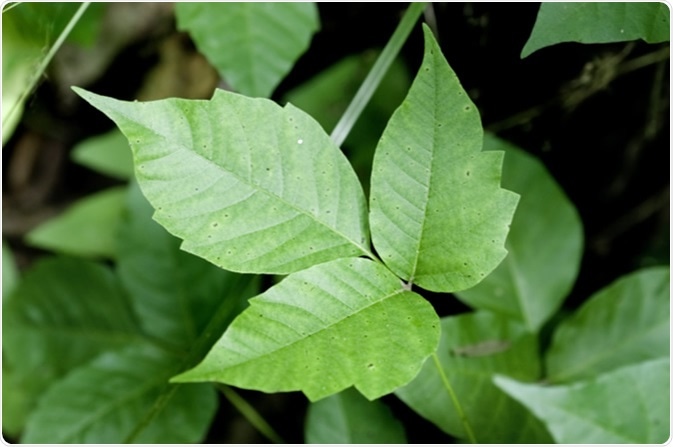Many poisonous plants are so common and seemingly harmless you do not suspect their toxic qualities. These plants can be a hazard to people and may cause a wide range of health consequences.
Skip to:
What plants are poisonous?
There are several plants that are considered poisonous. Toxic plants can cause adverse effects when ingested or through skin contact.
The three most common types of poisonous plants include poison oak, poison sumac, and poisonous ivy. All these plants contain a phenolic compound called urushiol (oleoresin), a highly irritating allergenic substance.

Close up detail of a Poison Ivy Plant. Image Credit: Tim Mainiero / Shutterstock
The most toxic component of urushiol is resin 3-n-pentadecylcatechol. The resin can cause an extremely painful, itchy, and blistering rash when they touch the skin.
A person can be exposed to urushiol directly or by touching items such as camping equipment, pet’s fur or gardening tool that have been exposed to the sap of toxic plants. Even the slightest contact such as brushing the leaves can trigger a reaction.
The alarming thing is, these plants grow everywhere, especially in wooded or marshy areas throughout North America. Other poisonous plants include poison hemlock, pothos, caladium, castor oil plant, foxglove, and peace lily, among others.
Many other plants cause allergic reactions or poisoning when ingested. The list of plants varies by geographic area, and unknown plants should never be ingested.

Poison Hemlock Conium maculatum. Image Credit: Vania Zhukevych / Shutterstock
What are the common health effects of poisonous plant exposure?
The potential danger depends on the dose of exposure. Some plants can cause serious illness or death with only a small amount while others may need large quantities to be consumed before symptoms to appear.
Poisoning from plants may happen from inhalation, ingestion, or direct contact. The common symptoms of plant poisoning through ingestion include diarrhea, nausea, vomiting, gastroenteritis, nervous system symptoms, and in severe cases, respiratory and cardiac problems. Poisoning through direct contact with the sap and other plant parts include blistering, rashes, and swelling. Inhalation of plant pollen, fumes, or dust may cause asthma-like symptoms.
Approximately 85 percent of the population is allergic to poison ivy, poison oak, or poison sumac. About 10 to 15 percent are tremendously allergic and may experience serious symptoms. In fact, as many as 5 million people in the United States experience allergic reaction to these plants each year.
How to prevent contact with poisonous plants?
Some of the poisonous plants like poison ivy are found in the woods and in some cases, suburban backyards. They may blend in with other brushes and plants, making it hard for people to distinguish it. Plant features may vary by location and therefore be difficult to identify.
The most important thing to do is to know how they look and determine the most common places they grow. This way, people can steer clear of them. If you’re unsure if there are poisonous plants in the area, wear protective clothing, including long-sleeved shirts and long pants when working in outdoor areas.
For those who are gardening, use gloves to extract plants and wash gardening tools after use. When your pet wandered into the woods, give it a bath after to wash off any urushiol oil that may be on his fur.
Barrier products for these plants are also available. These come in lotions, towelettes, and creams to prevent the plant oil from contacting the skin. Apply these products before you go outdoors to stay protected. Lastly, if you’re going to an area where these plants grow, know who to call in case of an emergency.
How are reactions to poisonous plants treated?
An allergic reaction to poison plants can’t be cured, but the symptoms can be managed. The treatment is typically limited to self-care methods since the rash goes away on its own in two to three weeks.
To help relieve the itching, you may take cool showers, apply cold compress, and apply over-the-counter lotions. If the rash is severe and widespread or if blisters appeared, the physician may prescribe oral corticosteroids. You should try to avoid scratching, as this can cause breaks in the skin that would allow bacterial infections.

Pointing at severe allergic reaction to poison ivy on a woman's arm. Image Credit: Michael Moloney / Shutterstock
If a severe allergic reaction develops, do not attempt to wait it out or treat it on your own. Go to the nearest emergency department or call emergency services. If the person is unresponsive, unconscious, or having a hard time breathing, call an ambulance, as they may be experiencing a life-threatening reaction.
If unsure of the type of plant that caused the reaction, carefully take a piece of the plant for identification. But, don’t handle the plant with bare hands, use gloves and put the plant in a zip bag.
Poisonous plants can cause a wide range of symptoms, in some cases, they can be potentially fatal. Preventing direct contact is imperative.